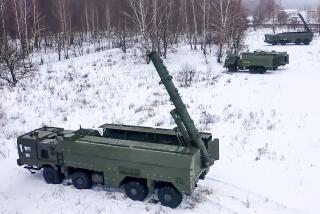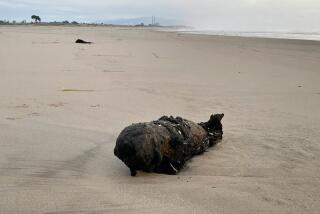Brass Wanted to ‘Erase’ Soldiers’ Fear of Radiation
- Share via
WASHINGTON — Troop exercises during nuclear bomb tests in the 1950s were designed to convince soldiers that their fear of radiation was irrational and to give them “an emotional vaccination,” newly declassified Pentagon records show.
It has been known for decades that soldiers were deliberately exposed to radiation during exercises starting in 1951 at the Nevada nuclear test range. The newly available documents open a window into the reasoning of military leaders in secret discussions about how far to go in using GIs in the tests.
The basic judgment, as reflected in the records, was that soldiers had an exaggerated fear of nuclear radiation after the two U.S. nuclear bombings of Japan in 1945. The solution was to put GIs in foxholes near ground zero of nuclear bomb blasts and then move them even closer after the shock wave passed.
Little consideration was given to longer-term health risks to the soldiers. The focus was on the short term, to erase what one general in a 1951 report called a “combat unfavorable psychology.”
In a newly declassified Pentagon briefing paper dated Feb. 27, 1953, the purpose of the indoctrination effort was described this way:
“To remove from the minds of the troops--and therefore to a degree from the minds of other persons in the services with whom they will later come in contact--the folklore and superstition regarding atomic explosions . . , particularly effects connected with nuclear radiation hazards.”
Military leaders felt this psychological manipulation was essential because of their belief that nuclear war with the Soviet Union could begin at any time.
The formerly secret Pentagon papers are among thousands of pages of documents of the now-defunct Armed Forces Special Weapons Project that have been declassified by the National Archives at the request of the Associated Press.
At least 40,000 men from all branches of the U.S. military participated in eight Desert Rock exercises in Nevada, from 1951 to 1957, according to the Pentagon.
Air Force Maj. Gen. Kenneth L. Hagemann, director of the Defense Nuclear Agency, which is reviewing Cold War-period radiation research on human subjects, told a congressional panel on Jan. 25, 1994, that about 1,600 individuals in the Desert Rock tests received radiation doses in excess of 5 roentgens. Today’s occupational exposure limit is 5 roentgens per year.
Some veterans now link serious ailments, including cancers, to their participation in the Nevada tests, and many have organized to win compensation. The extent of injuries or illnesses that can be blamed on Desert Rock is not clear.
More to Read
Sign up for Essential California
The most important California stories and recommendations in your inbox every morning.
You may occasionally receive promotional content from the Los Angeles Times.













